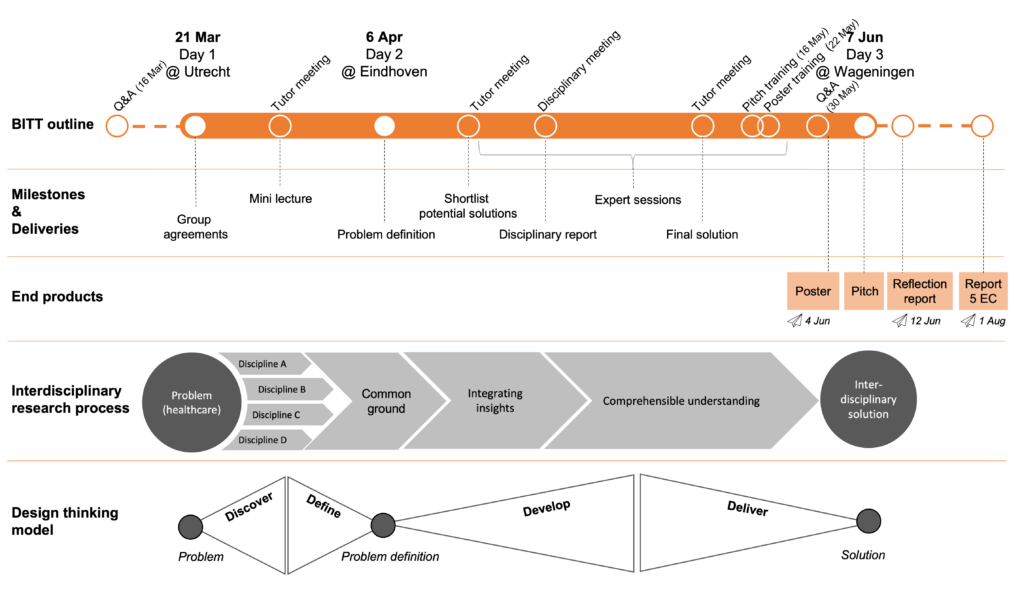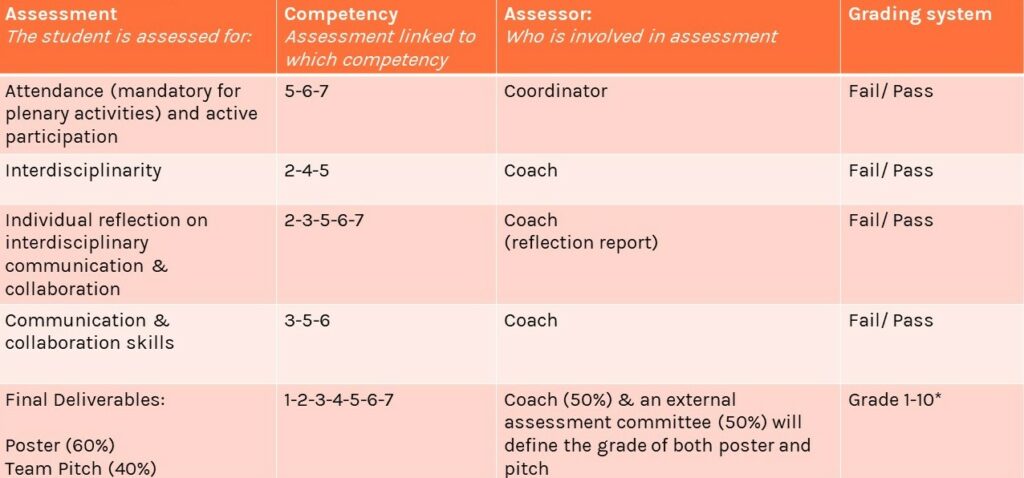In the Bio-Tech-Med Nutrition Interdisciplinary Team Training Challenge, master students from different programmes worked to find solutions to the challenges patients encounter. In this course of 3 to 5 ECTS, interdisciplinary student teams tackled the question:
“Besides tackling their disease, patients and experts experience other disease-related challenges. Patients face challenges that can be technical, medical, nutritional, or a combination of all. How can these challenges be tackled if the patient is placed in the main focus?“

Participants were stimulated to use an interdisciplinary approach to deliver patient-centered solutions. Solutions could combine technical, political, economic, social and sustainability disciplines. The proposed solutions would include a theoretical framework (of a device, platform, tool, etc.), a prototype thereof, a research proposal, a system or a policy, depending on the expertise of the team and the needs of the challenge itself.
Learning outcomes
After successful completion of this course, learners were expected to be able to:
- Translate a real-life disease-related problem into a well-formulated problem definition
- Reflect on their personal interdisciplinary collaboration experience, and on the added value of an interdisciplinary approach to solving a disease-related challenge
- Develop efficient communication skills that would engage the challenge stakeholders
- Embrace all stakeholders’ perspectives in the formulation of the solution to the disease-related challenge
- Contribute actively in the interdisciplinary collaboration and to enhance group dynamics
- Collaborate effectively while working in geographically distant settings and within a limited time frame
- Formulate, pitch, and defend a proposal that is scientifically sound, feasible, innovative, and interdisciplinary, which answers the problem definition.
Learning journey
In the educational design of this CBL course, a design-thinking approach was used to guide the team process towards the final deliverable, highlighting milestones and deadlines that learners had to meet (see visual below). In parallel, the design had a strong focus on the interdisciplinary research process, which guided the collaboration and co-creation among the learners to deliver a well rounded and informed interdisciplinary solution.
The process was divided into the following stages:
- Problem discovery/exploration: To clarify what the problem really entailed, learners started with a diverging discovery phase where all aspects of the problem were identified and explored. In multidisciplinary teams, students first collected all the data they could find about the issue, using each other’s expertise. In order to guide this process, a written guide was given to learners on Day 1 to explore their own discipline in parallel to the ones from their fellow learners.
- Problem definition: To decide which part of the problem was to be addressed, the potential directions of the problem were explored, evaluated, embraced, abandoned or combined. When the teams of learners fully understood the problem, they defined their specific team problem/challenge (Day 2 and following weeks). The contribution of the challenge agent in this phase was essential.
- Solution Development: Entering the diverging development phase, learners began their process of creating a working prototype (physical product, material or software). In this phase, various aspects of the product are identified, explored, developed, tested and collected. The problem definition, prototype and critical design steps were presented at the 3rd event (Day 3 in the visual).
- Solution Delivery: Finally, learners completed the delivery phase, where the prototype was put together and tested for functionality, bringing the course to a close.

Assessment
In this course, assessment was structured as in the table below. Learners needed to achieve all the listed criteria. If any were missed, the learner could appeal for a re-exam, by means of an individual, substitute assignment.

Instructions for all the deliverables are provided to the learners in forms of templates that you can find in our resources package .
The rules and regulations of the Utrecht University Graduate School of Life Sciences (GSLS) were applied to this elective. The documents, including the education and examination regulations and the rules and regulations of the Board of Examiners of the GSLS master programmes, are available here: GSLS study guide .
Course evaluation
Course evaluation took place during Day 3, the final event. Each learner completed an online questionnaire. More evaluation resources can be found here evaluation resources.
General information and contact details of this CBL course can be found on the EWUU website.
